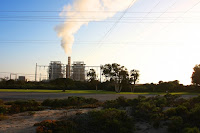Coal burning, despite recent signs of having peaked in China and pledges made at the Paris Climate talks in December, remains the primary source of electric power in Asia. In both China and India, it’s responsible for the lion’s share of human-made sulfur dioxide (SO2) emissions, which drive up concentrations of sulfate aerosols in the atmosphere. These aerosols not only endanger public health in the region but also contribute to local and global climate change.
Just how much climate change will depend on Asia’s energy choices in the years and decades to come. At one extreme, economic growth and energy demand in China, India, and other fast-growing Asian nations would lead to rapid increases in coal use, resulting in more significant climate impacts; at the other, Asia would gradually lessen these impacts by shifting from coal to cleaner burning fuels such as natural gas, and low-carbon energy technologies such as wind turbines and photovoltaics. Now a new study in the Journal of Climate assesses the climate’s likely response to aerosol emissions at both extremes, resulting in likely lower and upper bounds for the impact of Asian aerosols on regional surface temperature and rainfall.
According to the study, a high coal-use future — in which today’s emissions of sulfur dioxide and black carbon aerosols from Asia’s industry, energy, and domestic sectors are set to twice their year-2000 values from 2030 to 2100 — would entail significant local and global climate impacts.
Read more at Higher Coal Use in Asia Could Increase Water Stress

No comments:
Post a Comment